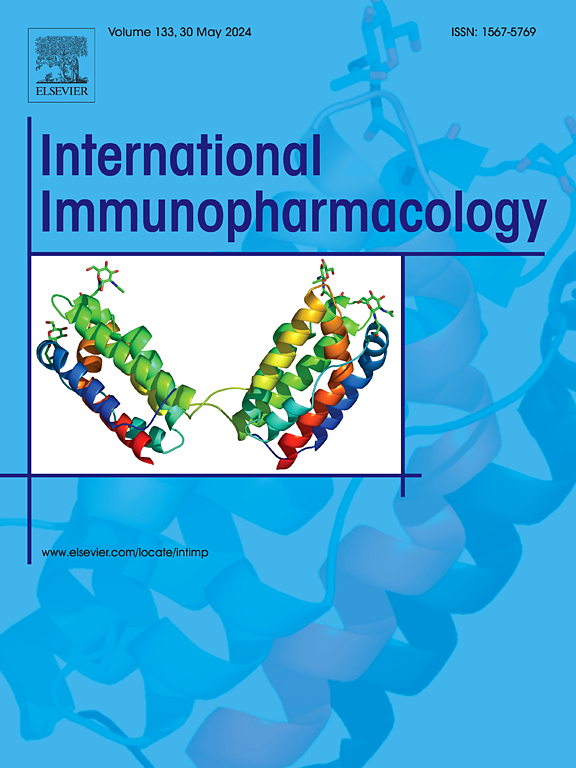Fibrotic extracellular matrix microenvironment induces alveolar type II epithelial cell senescence via integrin-β1/FAK/YAP signaling pathway
IF 4.7
2区 医学
Q2 IMMUNOLOGY
引用次数: 0
Abstract
Senescent alveolar epithelial cells (AEC) play a pivotal role in the progression of idiopathic pulmonary fibrosis (IPF), attracting increasing attention from researchers. Central to the pathogenesis of pulmonary fibrosis (PF) is the excessive deposition of extracellular matrix (ECM). However, there remains a significant gap in understanding how the ECM microenvironment influences senescence in type II alveolar epithelial cells (AEC II). This study investigates the activation of the integrin-β1/FAK/YAP signaling pathway and its role in inducing cellular senescence in both in vivo and in vitro models of bleomycin (BLM)-induced PF. We employed decellularized lung scaffolds (DLS) to replicate the natural ECM microenvironment, aiming to elucidate whether the fibrotic ECM promotes AEC II senescence through the integrin-β1/FAK/YAP pathway. Notably, our findings indicate that exogenous integrin-β1 does not induce AEC II senescence. This suggests that the fibrotic ECM microenvironment regulates AEC II senescence via the integrin-β1/FAK/YAP pathway independently of exogenous integrin-β1. Therefore, targeting alterations in the fibrotic ECM microenvironment may represent a promising therapeutic strategy for IPF by modulating AEC II senescence.
纤维化细胞外基质微环境通过整合素-β1/FAK/YAP信号通路诱导肺泡II型上皮细胞衰老
衰老肺泡上皮细胞(AEC)在特发性肺纤维化(IPF)的进展中起着关键作用,越来越受到研究者的关注。肺纤维化(PF)发病机制的核心是细胞外基质(ECM)的过度沉积。然而,在了解ECM微环境如何影响II型肺泡上皮细胞(AEC II)的衰老方面仍然存在重大差距。本研究探讨了整合素-β1/FAK/YAP信号通路的激活及其在博来霉素(BLM)诱导的PF体内和体外模型中诱导细胞衰老的作用。我们采用脱细胞化肺支架(DLS)复制天然ECM微环境,旨在阐明纤维化ECM是否通过整合素-β1/FAK/YAP通路促进AEC II衰老。值得注意的是,我们的研究结果表明外源性整合素-β1不会诱导AEC II衰老。这表明纤维化ECM微环境通过独立于外源性整合素-β1的整合素-β1/FAK/YAP通路调节AEC II衰老。因此,靶向纤维化ECM微环境的改变可能是通过调节AEC II衰老来治疗IPF的一种有希望的治疗策略。
本文章由计算机程序翻译,如有差异,请以英文原文为准。
求助全文
约1分钟内获得全文
求助全文
来源期刊
CiteScore
8.40
自引率
3.60%
发文量
935
审稿时长
53 days
期刊介绍:
International Immunopharmacology is the primary vehicle for the publication of original research papers pertinent to the overlapping areas of immunology, pharmacology, cytokine biology, immunotherapy, immunopathology and immunotoxicology. Review articles that encompass these subjects are also welcome.
The subject material appropriate for submission includes:
• Clinical studies employing immunotherapy of any type including the use of: bacterial and chemical agents; thymic hormones, interferon, lymphokines, etc., in transplantation and diseases such as cancer, immunodeficiency, chronic infection and allergic, inflammatory or autoimmune disorders.
• Studies on the mechanisms of action of these agents for specific parameters of immune competence as well as the overall clinical state.
• Pre-clinical animal studies and in vitro studies on mechanisms of action with immunopotentiators, immunomodulators, immunoadjuvants and other pharmacological agents active on cells participating in immune or allergic responses.
• Pharmacological compounds, microbial products and toxicological agents that affect the lymphoid system, and their mechanisms of action.
• Agents that activate genes or modify transcription and translation within the immune response.
• Substances activated, generated, or released through immunologic or related pathways that are pharmacologically active.
• Production, function and regulation of cytokines and their receptors.
• Classical pharmacological studies on the effects of chemokines and bioactive factors released during immunological reactions.

 求助内容:
求助内容: 应助结果提醒方式:
应助结果提醒方式:


